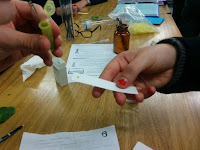In the article 'Supercrops: fixing the laws of photosynthesis', published by BDebora MacKenzie in 2010, there is a debate about which factors can be improved for more efficient photosynthesis.
Factors, which explain the inefficiency, are:
One way chould be, to reduce the chlorophyll level in plants, which is four times as much as is needed. This would help to transfer more light through the leaves to lower plants and leaves. The excess chlorophyll also leads to a too fast absorption of light, which can damage the leaves. Therefore a way to improve the plants would be to reduce chlorophyll.
Another aspect would be to improve the storing of the energy and shift it to edible parts of the plant. This has already happened and half the energy output is nowadays in the seeds of plants.
What has also been improved already in the past is the hight of plants, the position of the leaves, to perfectionise the sunlight capture.
A very big issue and waste factor of energy is the enzyme 'rubisco'. It is very slow and therefore there is needed a lot of it in a plant. Also it's grabbing of the CO2 Molecules is very inefficient and it accidentally sometimes takes oxygen instead, which leads to loss of one CO2. But to engineer rubisco to be more efficients seems impossible.
Other plants in the early atmosphere found a good solution to capture CO2 efficiently by using another enzyme to grab the CO2 and transfer it to another compartment of the cell where it is added to a 3C molecule to result in an 4C molecule, which was then given to the rubisco enzyme.This C4-photosynthesis is more efficient then C3 photosynthesis because it results in less photorespiration by oxygen adding and hence, has more yild.The C4 plants are more resistent to the climate change and generally need less nitrogen.
To tweak therefore C3 plants into C4 palnts is the aim, but it is hard to achieve because it is not just adding enzymes but also the compartments of C4 cells are needed.
While this is complicated, a better way could be to take the rubisco of C4 and add it into C3 photosynthase, because the C4 rubisco can work faster due to it's weaker bonding.
These where the major ideas of the article, which fit to the theme of photosynthesis we just work on in class. I think that the article shows how far science is in this area and that it is good to put further research into that field because there are already good thoughts of solutions in the research and it could have a major impact on us with the climate change and food supply.
Sonntag, 31. Januar 2016
Sonntag, 24. Januar 2016
Separation of Chlorophyll Pigments by Paper
In my biology lesson we did a chromatography of chloroplast extract:
At first we added a spatula of anhydrous sodium sulphate into an Eppendorf tube.
Then we placed small pieces of spinach leaves into the tube and 5 drops of solvent A (2 parts ethyl ethanoate and 3 parts propanone) and stired al of it a metal probe:
Now we placed a dot of the solvent on a TLC plate with 5 mm space from the bottom edge:
After this we used a dropper pipette to place solvent B(5:3:2 mixture of cyclohexane, ethyl ethanoane and propanone) into a new vial (5mm hight of solution).
Finally we put the TLC plate into the vial and waited for a few minutes, so that the result was as shown here:
At first we added a spatula of anhydrous sodium sulphate into an Eppendorf tube.
Then we placed small pieces of spinach leaves into the tube and 5 drops of solvent A (2 parts ethyl ethanoate and 3 parts propanone) and stired al of it a metal probe:
Now we placed a dot of the solvent on a TLC plate with 5 mm space from the bottom edge:
After this we used a dropper pipette to place solvent B(5:3:2 mixture of cyclohexane, ethyl ethanoane and propanone) into a new vial (5mm hight of solution).
Finally we put the TLC plate into the vial and waited for a few minutes, so that the result was as shown here:
Abonnieren
Posts (Atom)


